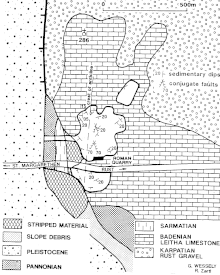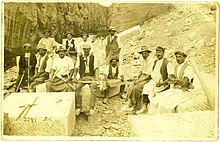St. Margarethen sand-lime brick
The St. Margarethener sand-lime stone is one of the most important natural stones from the group of Leithakalke in eastern Austria, which was used on numerous historical buildings and monuments.
General and geographic location
The Roman quarry near Sankt Margarethen in Burgenland is one of the most important still active stone quarries in Austria, with great cultural and historical importance. In addition, this quarry , which has been largely disused , is, in addition to an interesting touristic excursion point, a valuable locality worth protecting from the historical point of view of stone extraction and use.
Pannonian climate with dry grass - socialization , bat colonies in the numerous crevices (e.g. sea urchin crevice, bat crevice etc.), jackdaws, kestrels and many others make this quarry an important location from an ecological point of view.
Last but not least, the St. Margarethen Sculpture Symposium , which was established in the St. Margarethen quarry in 1959 and whose idea originated from Karl Prantl, was of outstanding cultural and social importance, as were the Passion Plays and open-air operas presented in recent years .
Geological overview
The Rust hill country with its core of central alpine metamorphic rocks , located between Lake Neusiedl and Leithagebirge , formed a high zone in the Badenium on which shallow water sediments were deposited in the form of lime sands. The Leithagebirge, located to the west, protruded as an island from the generally quite flat gulf of the western Paratethys .
The St. Margarethener sand-lime stone is assigned to the geological formation Leithakalk and is around 15-16 million years old ( Badenium ). The most important rock formers of the Leithakalke are skeletons of red algae of the Corallinaceae family and foraminiferous shells . The sedimentation of the sand-lime brick took place in a shallow marine, lagoon-like environment under subtropical climatic conditions.
Petrographic description
They are yellow-brown to light-gray, fine to coarse-grained, porous limestones , which also have several large, spherical red algae colonies and various mussels (e.g. Ostrea sp. , Pecten sp. , Chlamys sp. ). In the thin section , the St. Margarethener stone shows itself as a very porous sand-lime stone, which is mainly composed of small fragments of red calcareous algae and foraminifera. In addition, one can observe echinoderm spar , fragments of calcareous tube worms and ostracods .
The diagenesis was carried out with fine-grain calcite .
Facies : marine, agitated shallow water area (algae-foraminifera-sand-lime stone)
Technical and physical parameters
- uniaxial compressive strength : 30-50 N / mm 2
- Flexural strength : 7-10 N / mm 2
- Splitting tensile strength : 0.8-2.9 N / mm 2
- Bulk density : 1.97-2.26 g / cm 3
- effective porosity : 16-25 R.%
- Water absorption : 3.6-10.2 mass%
Weathering behavior

The weathering of these rocks takes place through complex chemical and physical processes. There are several different varieties in the entire quarry area, which also differ significantly from one another in terms of their technical characteristics and weather resistance; The more porous, less firm, crumbly varieties that were used in the past in the now disused quarry areas tend to form crusts and were only partially frost-resistant and susceptible to damage from crystallizing masonry salts ( sulfates , chlorides , nitrates ). This variety is no longer mined or used today.
The harder, more solid variety, which is currently being dismantled in a painting continuation of the legendary St. Stephen's Wall, is to be regarded as significantly cheaper and longer-lasting with regard to any weathering stress.
Historical meaning
A local late medieval stone extraction can be proven with certainty, with a possible use of the stone in the 15th century for some construction phases on the south tower of St. Stephen's Cathedral in Vienna . But the quarried stone was also used as building material in Roman Carnuntum .
However, this rock deposit only gained supra-regional importance from the 16th / 17th centuries. Century. The quarry has been owned by the Esterházy family since then and has supplied huge quantities of sand-lime bricks for numerous splendid Baroque buildings and the Vienna Ringstrasse .
Prominent examples of use in the Vienna area include the fountain house of the "beautiful fountain" and numerous architectural and decorative parts of the Roman ruins of Schönbrunn Palace , Vienna City Hall , the outer facade of the Vienna Südbahnhof , which was demolished in 2010 , the Vienna Musikverein building , the Vienna Stock Exchange and others. v. a. m. represent.
In the quarry , which is still in operation today, there is also the legendary "Stephanswand", whose sandstone was reserved for restoration work on St. Stephen's Cathedral in Vienna from 1841 onwards.
Methods of raw ingot extraction
Historical
Schrämen with the bifurcated , the characteristic degradation tracks (Schrämspuren) leaves.
Current
Today, in the quarry in operation, rough blocks in the format of around 2.5 × 1.3 × 1.5 meters are mined using a cutting machine , which are then further cut into solid workpieces or panels using a gang saw or circular stone saw, depending on the requirements. Due to its homogeneity and easy workability, the St. Margarethen sand-lime brick is suitable for all solid work outdoors and indoors as well as for facade cladding and floor panels .
An important area of application of the St. Margarethen sand-lime brick is also its use as a substitute material in the field of monument preservation ( Federal Monuments Office ), as numerous historical architectural monuments in Eastern Austria consist of this or similar Leithakalken.
The dismantling volume is currently a maximum of 500 m 3 / year.
Wedge the ingot from the rock below
literature
- WC Dullo: Fossil diagenesis in the Miocene Leithakalk of the Paratethys of Austria: An example of faunal shifts due to differences in diagenesis. In: Facies 8 (1983), Erlangen, pp. 1-112.
- W. Fuchs: Geology of the Ruster Bergland (Burgenland). In: Jb. Geol. B.-A. 108 (1965), pp. 155–194 ( article pdf , geologie.ac.at).
- Mathias Harzhauser, Werner E. Piller: St. Margarethen: The most diverse among the quarries. In: T. Hofmann (Ed.): Vienna Lower Austria Burgenland. = Walks in the history of the earth 22 (2007), Verlag Dr. Fritz Pfeil, Munich, ISBN 978-3-89937-074-4 , hike no. 79, pp. 165–168 - with: Erich Draganits, Bernhard Grasemann, Ulrike Exner: Tektonik. Andreas Rohatsch : Use.
- Werner E. Piller, Kurt Decker, Margit Haas: Sedimentology and basin dynamics of the Vienna basin. In: Excursion guide 11th sedimentologist meeting. = Reports of the Federal Geological Institute 33 (1996), Vienna ( article pdf , geologie.ac.at).
- R. Laner: Deformation bands in neogene sand-lime bricks in the Eisenstadt basin (St. Margarethen, Burgenland). Unpublished bachelor thesis, Department of Geodynamics and Sedimentology, University of Vienna, 2009.
- A. Rohatsch: Neogene building and decorative stones from Lower Austria and Burgenland. In: B. Schwaighofer, W. Eppensteiner (Hrsg.): Series Usable Rocks from Lower Austria and Burgenland , Volume "Young" Limes, Sandstones and Conglomerates - Neogen. Self-published by IAG BOKU, Vienna 2005 ISSN 1021-7533 .
- R. Sauer, P. Seifert, G. Wessely (Eds.): Guidebook to Excursions in the Vienna Basin and the Adjacent Alpine-Carpathian Thrustbelt in Austria. Hiking conference of the Austrian Geological Society 14. – 18. September 1992 in Vienna "Underground and peripheral areas of the Vienna Basin" = communications of the Austrian Geological Society 85 (1992), Vienna ( Downloads pdf , geol-ges.at).
Web links
- Sculpture symposium in the St.Margarethen quarry
- The place St. Margarethen on die-st-margarethener.at
- Stone surface of the St. Margarethen sand-lime brick
- Gustav Hummel GmbH & Co KG - stonemasons and quarries, marble workshops
- Federal Geological Institute: Gaissriegel (Osliper concrete plant)
- Federal Geological Institute: St. Margarethen (Hummel)
Individual evidence
- ↑ Festival area in the Roman quarry on nextroom accessed on April 19, 2010
Coordinates: 47 ° 48 ′ 11 ″ N , 16 ° 38 ′ 0 ″ E








